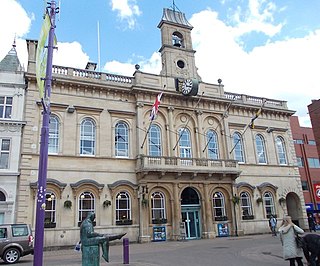
The Loughborough Town Hall is a building fronting onto the Market Place in Loughborough, Leicestershire, England. Built as a corn exchange and ballroom in 1855, it became a municipal building and subsequently a theatre. It is a Grade II listed building.

Cromer Hall is a country house located one mile south of Cromer on Holt Road, in the English county of Norfolk. The present house was built in 1829 by architect William Donthorne. The hall is a grade II* listed building.
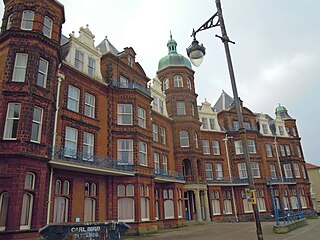
The Hotel de Paris is a hotel in the English seaside town of Cromer in the county of Norfolk, United Kingdom. It has an AA three-star rating.
Augustus Frederic Scott (1854–1936) a Norwich-based Architect who was born in 1854 in the Breckland village of Rockland St Peter, Norfolk. His work included both civic and ecclesiastical buildings, in addition to several large hotels and many private commissions.

The Queen's Hall, formerly Hexham Town Hall, is a municipal structure in Beaumont Street, Hexham, Northumberland, England. The structure, which was the headquarters of Hexham Urban District Council and is now an arts centre, is a Grade II listed building.

The Shire Hall is a municipal structure in Broad Street, Presteigne, Powys, Wales. The building incorporates a well-preserved courtroom and a museum known as "the Judge's Lodging". Once the judicial centre for Radnorshire, is a Grade II* listed building.

The Shire Hall is a municipal structure in Glanhwfa Road, Llangefni, Anglesey, Wales. The building, which served as the headquarters of Anglesey County Council, is a Grade II listed building.

North Tawton Town Hall is a municipal building in The Square, North Tawton, Devon, England. The town hall, which is the meeting place of North Tawton Town Council, is a Grade II listed building.

Seaton Town Hall is a municipal building in Fore Street, Seaton, Devon, England. The town hall, which was the meeting place of Seaton Urban District Council, is now used as a theatre.

Crail Tolbooth and Town Hall is a municipal structure in Crail, Fife, Scotland. The building, which stands in Marketgate, at its junction with Tolbooth Wynd, is Category A listed.

Chipping Norton Town Hall is a municipal building in the Market Place, Chipping Norton, Oxfordshire, England. The building, which is used as an events venue, is a Grade II* listed building.
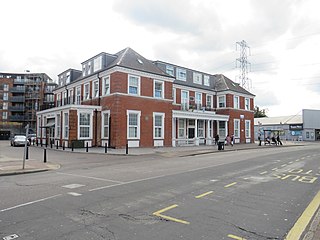
Crayford Town Hall is a former municipal building in the High Street in Crayford Road, Crayford, London, England. The structure, which was formerly the offices and meeting place of Crayford Urban District Council, is a locally listed building.
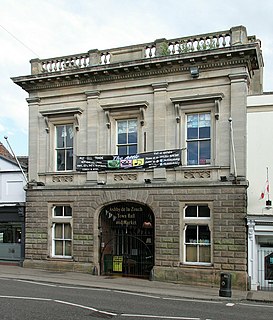
Ashby-de-la-Zouch Town Hall is a municipal building in Market Street in Ashby-de-la-Zouch, Leicestershire, England. The structure, which was used as the offices of Ashby-de-la-Zouch Urban District Council, is a Grade II listed building. The market hall, which is located behind the town hall, is separately listed.

Sheringham Town Hall, formerly known as Sheringham Council Offices, is a former municipal building in Church Street, Sheringham, Norfolk, England. The structure served as the headquarters of Sheringham Urban District Council and then as the offices and meeting place of Sheringham Town Council until it closed in August 2019.

Aylsham Town Hall is a municipal building in the Market Place in Aylsham, Norfolk, England. The structure, which accommodates the offices and meeting place of Aylsham Town Council, is a grade II listed building.

Hunstanton Town Hall is a municipal building on The Green in Hunstanton, Norfolk, England. The structure, which is the meeting place of Hunstanton Town Council, is a grade II listed building.

Stokesley Town Hall is a municipal building in the Market Place in Stokesley, North Yorkshire, England. The structure, which accommodates the offices and meeting place of Stokesley Town Council, is a grade II listed building.

The Town House is a municipal building in Union Street in Yeovil, Somerset, England. The building, which is the meeting place of Yeovil Town Council, is a Grade II listed building.

Hanley Town Hall is a municipal building in Albion Square in Hanley, Staffordshire, England. The building, which is used as the local register office, is a Grade II listed building.
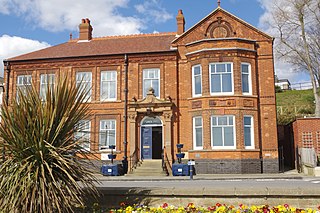
Felixstowe Town Hall is a municipal building in Undercliff Road West, Felixstowe, Suffolk, England. The building is the meeting place of Felixstowe Town Council.




















